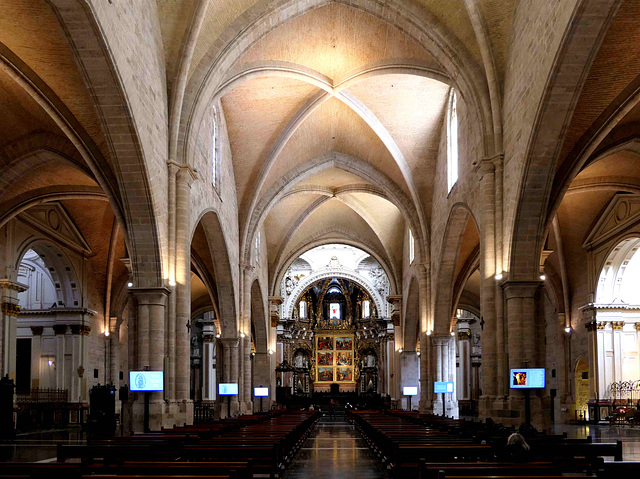Valencia - Catedral de Santa María
Valencia - Catedral de Santa María
Valencia - Catedral de Santa María
Valencia - Catedral de Santa María
Valencia - Catedral de Santa María
Valencia - Catedral de Santa María
Valencia - Catedral de Santa María
Valencia - Catedral de Santa María
Valencia - Catedral de Santa María
Valencia - Catedral de Santa María
Valencia - Catedral de Santa María
Valencia - Catedral de Santa María
Valencia - Catedral de Santa María
Valencia - Catedral de Santa María
Valencia - Catedral de Santa María
Valencia - Catedral de Santa María
Location
Lat, Lng:
Lat, Lng:
You can copy the above to your favourite mapping app.
Address: unknown
Lat, Lng:
You can copy the above to your favourite mapping app.
Address: unknown
See also...
Keywords
Authorizations, license
-
Visible by: Everyone -
All rights reserved
-
56 visits
Valencia - Catedral de Santa María


According to the Roman historian Titus Livius "Valentia" was founded by Consul Decimus Iunius Brutus Callaicus in the 4th century BC,
A century later "Valentia Edetanorum" became one of the first Hispanic cities to become a Roman colony.
The city made rapid progress after the Arab conquest in 711, reaching 15,000 inhabitants in the Caliphate of Córdoba. The Amirids and the Dhun Nunids ruled in “Balansiya”. In 1094, El Cid, a Castilian noble, conquered the city. The conquest was not carried out on behalf of one of the Christian kingdoms, but on the Cid's own account, who proclaimed himself "Señor de Valencia" and thus created a kind of private kingdom. He was able to defend the city against several Almoravid attacks, and after his death in 1099, his widow Jimena managed to hold Valencia until 1102, when it fell to the Almoravids, and a little later to the Almohads.
After the victory of the united Christian armies over the Almohads in the Battle of Las Navas de Tolosa (1212), Moorish Spain fell apart again into individual small kingdoms, including a Taifa from Valencia.
It was finally conquered in 1238 by Jaime I de Aragón (aka "el Conquistador"), after a five-month siege.
In the 15th century, the city grew rapidly and developed into one of the largest Mediterranean ports and an important trade and financial center. At the beginning of the 15th century the city had around 40,000.
There was once a Roman temple on the site of the church, which was converted into a Visigothic church after the Muslim conquest and converted into a mosque. After the reconquest in 1237, it became a church again.
The construction of the current Gothic-style building began in 1262 and was completed in the 15th century. However, its construction went on for centuries, so there is a mixture of Renaissance, Baroque, and Classicism styles.
A century later "Valentia Edetanorum" became one of the first Hispanic cities to become a Roman colony.
The city made rapid progress after the Arab conquest in 711, reaching 15,000 inhabitants in the Caliphate of Córdoba. The Amirids and the Dhun Nunids ruled in “Balansiya”. In 1094, El Cid, a Castilian noble, conquered the city. The conquest was not carried out on behalf of one of the Christian kingdoms, but on the Cid's own account, who proclaimed himself "Señor de Valencia" and thus created a kind of private kingdom. He was able to defend the city against several Almoravid attacks, and after his death in 1099, his widow Jimena managed to hold Valencia until 1102, when it fell to the Almoravids, and a little later to the Almohads.
After the victory of the united Christian armies over the Almohads in the Battle of Las Navas de Tolosa (1212), Moorish Spain fell apart again into individual small kingdoms, including a Taifa from Valencia.
It was finally conquered in 1238 by Jaime I de Aragón (aka "el Conquistador"), after a five-month siege.
In the 15th century, the city grew rapidly and developed into one of the largest Mediterranean ports and an important trade and financial center. At the beginning of the 15th century the city had around 40,000.
There was once a Roman temple on the site of the church, which was converted into a Visigothic church after the Muslim conquest and converted into a mosque. After the reconquest in 1237, it became a church again.
The construction of the current Gothic-style building began in 1262 and was completed in the 15th century. However, its construction went on for centuries, so there is a mixture of Renaissance, Baroque, and Classicism styles.
Marco F. Delminho, kiiti, Paolo Tanino, Philippe Collard have particularly liked this photo
- Keyboard shortcuts:
Jump to top
RSS feed- Latest comments - Subscribe to the comment feeds of this photo
- ipernity © 2007-2024
- Help & Contact
|
Club news
|
About ipernity
|
History |
ipernity Club & Prices |
Guide of good conduct
Donate | Group guidelines | Privacy policy | Terms of use | Statutes | In memoria -
Facebook
Twitter

Sign-in to write a comment.